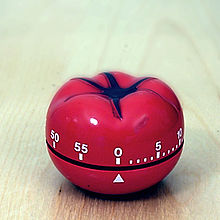Pomodoro technique
The Pomodoro technique (orig. Pomodoro technique from Italian pomodoro = tomato and English technique = method, technique) is a method of time management that was developed by Francesco Cirillo in the 1980s. The system uses a short-term alarm clock to divide work into 25-minute periods - called pomodori - and break times. The name pomodoro comes from the kitchen clock that Cirillo used in his first attempts.
The method is based on the idea that frequent breaks can improve mental agility.
method
The technique consists of five steps:
- formulate the task in writing
- set the minute minder to 25 minutes
- edit the task until the alarm goes off; mark with an X.
- take a short break (5 minutes)
- take a longer break after every four pomodori (15-20 minutes)
Underlying Principles
The planning, tracking, recording, processing and visualization phases are the essential pillars of this technology. In the planning phase, the tasks are written according to priority in a list for the current day. The respective effort is estimated.
As soon as a pomodoro is done, it is crossed out, which creates a feeling of success and provides data for later self-reflection and possibly project management.
An important goal of the technology is to reduce internal (wandering) as well as external (telephone, e-mail) interruptions. These interruptions are written down for later processing. Another advantage is the timeboxing of the task, which should reduce the internal resistance. Large tasks in particular are often not approached with pleasure due to their size. The fixed time frame of 25 minutes is intended to enable a start or continuous progress.
Tools
The inventor of the technology advocates the use of the simplest possible tools: a pencil and a mechanical kitchen clock. In his opinion, winding up the kitchen alarm underscores the determination to begin the task, and the ticking and ringing causes a different perception of time.
Nonetheless, the technology has inspired a large number of application software that is available for a variety of operating systems.
See also
literature
- Francesco Cirillo: The Pomodoro Technique. 3. Edition. FC Garage, Berlin 2013, ISBN 978-3-9815679-0-8
- Staffan Nöteberg: The Pomodoro Technique in Practice. dpunkt, Heidelberg 2011, ISBN 978-3-89864-717-5
Web links
- Pomodorotechnique.com Website by Francesco Cirillo
Individual evidence
- ↑ Frequently Asked Questions . pomodorotechnique.com, accessed November 3, 2010
- ↑ Shellenbarger, Sue (November 2009) The Wall Street Journal - "Testing Time Management Strategies"
- ↑ Tambini, Arielle; Ketz, Nicholas; Davachi, Lila "Enhanced Brain Correlations during Rest Are Related to Memory for Recent Experiences" Neuron (January 2010)
- ^ Francesco Cirillo: The Pomodoro Technique. Lulu.com, 2009, ISBN 978-1-4452-1994-3 ( free PDF version ( memento of the original dated December 18, 2013 in the Internet Archive ) Info: The archive link was inserted automatically and has not yet been checked. Please check the original and archive link according to the instructions and then remove this note. ).
